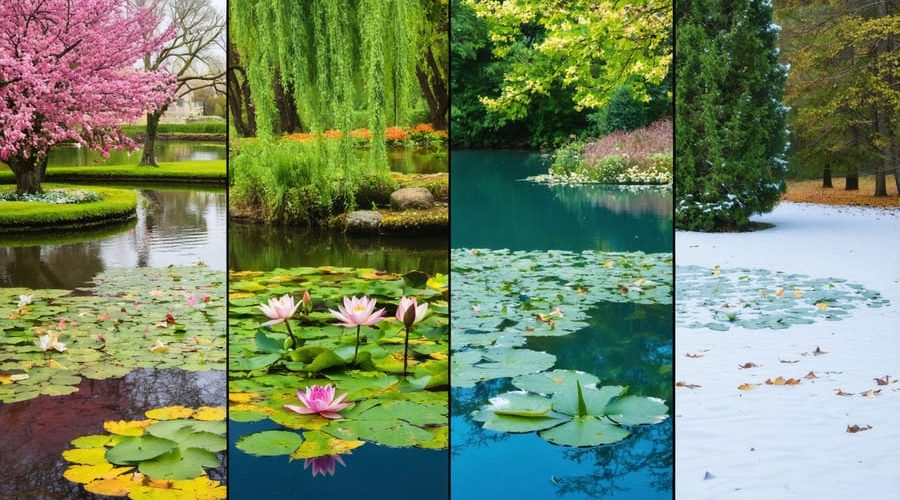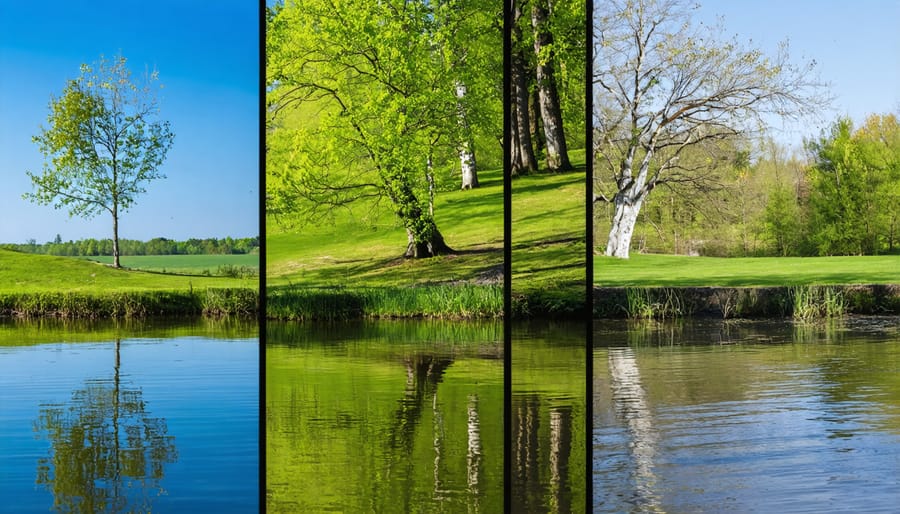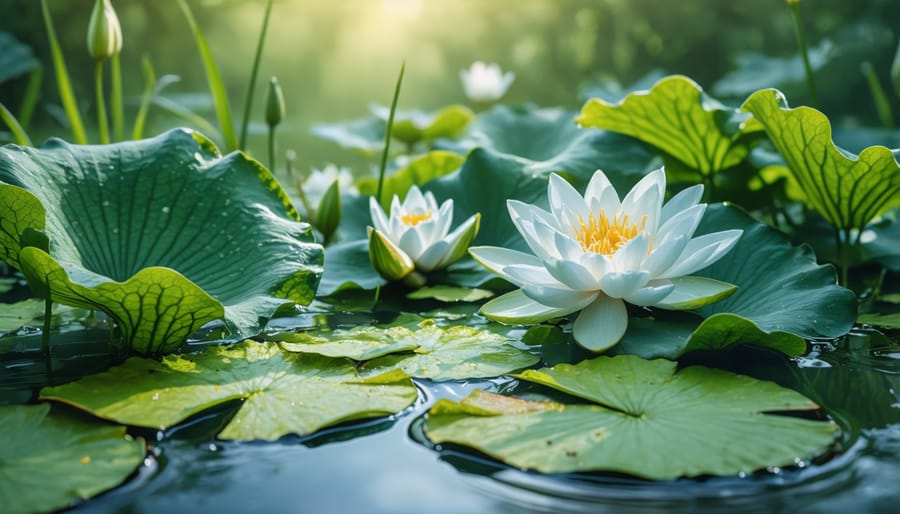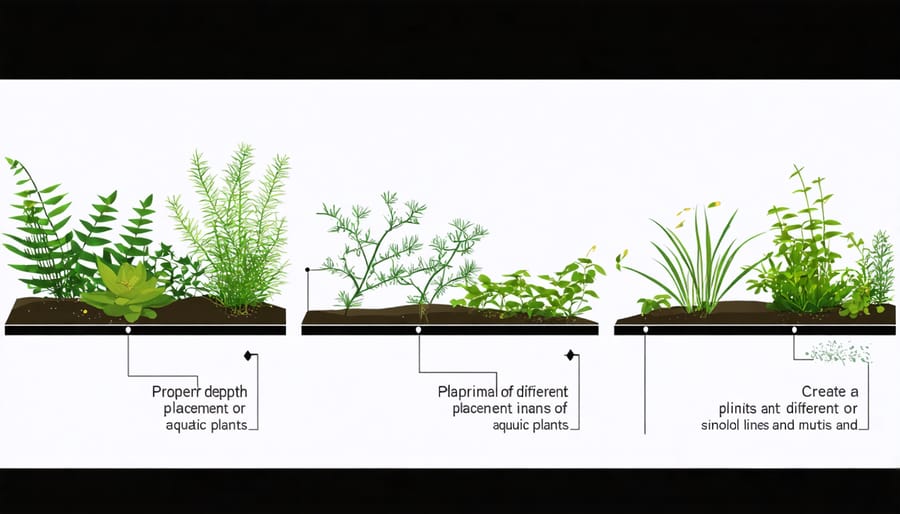
Keep Your Pond Vibrant Year-Round with These Hardy Water Plants
Transform your pond into a year-round aquatic paradise by strategically selecting plants that thrive across all seasons. Four-season plants create stunning visual interest while maintaining pond beauty through every temperature change and weather condition. From winter-hardy water lilies that retreat below the surface during cold months to towering umbrella plants that provide summer shade, these resilient species work together to keep your water garden vibrant and balanced throughout the year. By incorporating both marginal and floating varieties, you’ll create essential layers of protection and interest that evolve naturally with each passing season, ensuring your pond remains a dynamic focal point in your landscape no matter the month.

Spring Stars: Plants That Wake Up Your Pond
Early Spring Emergents
As winter’s grip loosens, early spring emergents burst forth with renewed vigor, offering the first signs of life in your four-season garden. These hardy pioneers include the cheerful yellow blooms of Winter Aconite, often pushing through the last patches of snow in late February or early March. Snowdrops follow closely behind, their delicate white flowers nodding in the crisp spring breeze.
Hellebores, also known as Lenten Roses, provide stunning early-season color with their long-lasting blooms in shades of pink, purple, and white. These reliable performers often begin flowering while frost still covers the ground. Crocus and Glory-of-the-Snow create vibrant carpets of color, while early daffodils stand tall against spring winds.
For shaded areas, consider Bloodroot and Virginia Bluebells, which emerge early and provide essential nectar for awakening pollinators. These early bloomers not only brighten the landscape but also set the stage for the spectacular show of mid-spring flowers to come.
Spring Maintenance Tips
As winter fades, your four-season plants need some special attention to thrive in the coming growing season. Start by gently removing any dead leaves or debris that accumulated during winter. This prevents rot and allows new growth to emerge freely. Inspect your plants for signs of damage from frost or pests, trimming away any affected areas with clean, sharp pruners.
Early spring is the perfect time to divide overgrown plants and refresh the soil around their roots. Add a slow-release fertilizer to give them a nutrient boost as they enter their active growing phase. Keep an eye on soil moisture levels – while spring usually brings rain, newly awakening plants might need supplemental watering during dry spells.
Watch for emerging shoots and protect them from late frosts with floating row covers if needed. As temperatures warm, gradually increase watering frequency to support new growth. Remember that different plants wake up at different times, so be patient and let each variety emerge at its natural pace.
Summer Performers: Heat-Loving Aquatics
Surface Floaters and Deep-Water Plants
During summer months, floating plants like water lilies and lotus create essential shade that helps maintain cooler water temperatures and reduces algae growth. These beautiful floaters not only add visual interest but also provide shelter for fish and help oxygenate your pond. Water lilies, with their stunning blooms and broad leaves, can cover up to 60% of your water surface, creating the perfect balance of sun and shade.
Deep-water plants like anacharis and hornwort work beneath the surface, releasing oxygen and absorbing excess nutrients that might otherwise feed unwanted algae. These underwater warriors also provide natural filtration and create safe spaces for small fish and beneficial microorganisms.
For the best results, combine both types of plants in your pond. A good rule of thumb is to aim for 40-60% surface coverage with floaters while maintaining several clusters of deep-water plants in varying depths. This creates a natural ecosystem that practically maintains itself, requiring minimal intervention from you while providing maximum benefits throughout the warmer seasons.

Summer Care Requirements
During summer, your four-season plants will require extra attention as they enter their peak growing period. The summer care requirements focus primarily on maintaining proper moisture levels and preventing overexposure to intense sunlight.
Water deeply but less frequently to encourage deep root growth, which helps plants become more resilient. Most four-season plants benefit from morning watering, allowing foliage to dry before evening to prevent fungal issues. Apply a layer of mulch around your plants to retain moisture and keep roots cool.
Regular deadheading of spent blooms encourages continuous flowering and prevents plants from going to seed too early. Watch for signs of heat stress, such as wilting or yellowing leaves, and provide temporary shade if needed. Feed your plants with a balanced, water-soluble fertilizer every 4-6 weeks during this active growing period.
Trim back any excessive growth to maintain plant shape and ensure good air circulation. Remember to check for pests more frequently during summer, as warm weather can increase insect activity.
Autumn Athletes: Fall-Interest Plants
Late-Season Bloomers
As summer fades, late-season bloomers take center stage, providing a spectacular finale to the growing season. Sedum ‘Autumn Joy’ steals the show with its deep pink flower heads that mature to rich copper, attracting butterflies well into fall. Japanese Anemones dance on tall stems, their delicate pink or white blooms adding grace to autumn gardens.
Chrysanthemums offer reliable bursts of color in countless shades, while Asters paint the landscape in purples and blues. For dramatic height, consider Japanese Toad Lily with its orchid-like spotted blooms, perfect for shadier spots.
Don’t forget ornamental grasses like Miscanthus and Pennisetum, which reach their peak beauty in fall with stunning plumes that catch the light. Their dried stalks continue to add interest throughout winter. For ground cover, try Heuchera varieties, whose colorful foliage intensifies as temperatures drop, creating a rich tapestry of burgundy, amber, and bronze tones.
Fall Preparation Steps
As temperatures drop, it’s crucial to prepare your four-season plants for the challenges ahead. Start by removing any dead or yellowing foliage to prevent decay from affecting healthy growth. Trim back perennials to about 2-3 inches above the soil line, but leave ornamental grasses standing as they provide winter interest and protection.
Apply a thick layer of mulch around your plants, about 3-4 inches deep, to insulate the root systems from freeze-thaw cycles. For container plants, consider moving them closer to your house or into a sheltered area to provide additional protection from harsh winds.
If you have evergreen plants, spray them with an anti-desiccant to prevent winter burn and moisture loss. Water your plants thoroughly before the ground freezes – this final deep watering helps plants survive winter dormancy. For sensitive plants, consider using burlap wraps or frost protection covers when severe weather is forecasted.
Remember to collect seeds from spent flowers for next year’s garden and clean up any fallen debris to prevent pest and disease issues during winter.
Winter Warriors: Cold-Hardy Varieties
Evergreen Aquatics
For year-round water garden beauty, several aquatic plants maintain their verdant appearance even during the coldest months. Water rush and sweet flag stand as reliable choices, offering striking vertical interest with their emerald stems that peek through winter ice. Japanese iris, though dormant above water, keeps its underwater foliage green, providing essential shelter for pond life.
The ever-dependable watercress not only stays green but continues growing in cold water, making it both decorative and edible. Hardy underwater plants like anacharis and hornwort remain vibrant beneath the surface, helping maintain water quality while providing welcome winter color.
To ensure success with evergreen aquatics, plant them in deep enough water to prevent freezing solid. Most perform best when positioned at least 18 inches below the surface in colder regions. Remember to trim dead foliage before winter sets in, allowing the healthy green growth to shine through the quiet season. These steadfast plants prove that water gardens can remain lively and interesting even during winter’s embrace.
Winter Protection Strategies
Protecting your four-season plants during harsh weather requires careful planning and execution. Implementing effective winter protection strategies can make the difference between thriving plants and winter casualties. Start by moving potted specimens closer to buildings or sheltered areas. For in-ground plants, apply a thick layer of mulch around the base – about 3-4 inches deep – using materials like straw, leaves, or bark chips. Consider installing temporary windbreaks using burlap screens or creating protective structures with stakes and frost cloth for more delicate specimens.
Don’t forget to wrap particularly vulnerable plants in breathable materials, avoiding plastic which can trap moisture and cause rot. For smaller plants, you can use plastic garden cloches or repurposed milk jugs with the bottoms cut off. Remember to water your plants thoroughly before the ground freezes, as moist soil retains heat better than dry soil. On particularly cold nights, consider using outdoor heating cables or frost protection fleece for extra security.

Plant Selection and Placement Tips
When selecting four-season plants, start by assessing your garden’s growing conditions, including sun exposure, soil type, and climate zone. Choose plants that naturally thrive in your area to ensure year-round success. Consider placing evergreen varieties as backdrop plants, creating a constant green foundation that other seasonal plants can complement.
Layer your plantings by height, with taller specimens at the back and shorter ones in front. This creates visual depth and ensures smaller plants aren’t overshadowed. Group plants with similar water and sunlight needs together to simplify maintenance and promote healthy growth.
For maximum impact, position plants where they’ll be visible from your most-used viewing areas, like windows or outdoor seating spaces. Consider how plants will look during their dormant phases too – some plants, like ornamental grasses, provide winter interest through dried stalks and seed heads.
Mix textures and forms to maintain visual interest throughout the year. Combine plants with different blooming periods to ensure continuous color. For example, pair early-spring bulbs with summer-flowering perennials and late-blooming asters.
Don’t forget to leave enough space between plants for mature growth. While it might look sparse initially, proper spacing prevents overcrowding and reduces maintenance needs later. Consider the mature size of each plant and space accordingly, typically following the planting instructions on plant tags or labels.
Remember to include plants with winter appeal, such as those with colorful bark, interesting branching patterns, or persistent berries. These features become especially important when other plants are dormant.
By incorporating four-season plants in your pond, you create a living landscape that delights throughout the year. From vibrant spring blooms to striking winter silhouettes, these carefully chosen plants ensure your water garden remains a focal point in every season. Not only do they provide visual interest, but they also support local wildlife, maintain water quality, and reduce maintenance needs. Starting your four-season pond garden might seem challenging at first, but the rewards are well worth the initial planning. Begin with a few reliable plants from each season and gradually expand your collection as you gain confidence. Remember, a thoughtfully designed pond with year-round interest adds value to your property and creates a peaceful retreat you can enjoy no matter the weather. Take the plunge and transform your pond into a dynamic, ever-changing display of natural beauty that celebrates every season.
